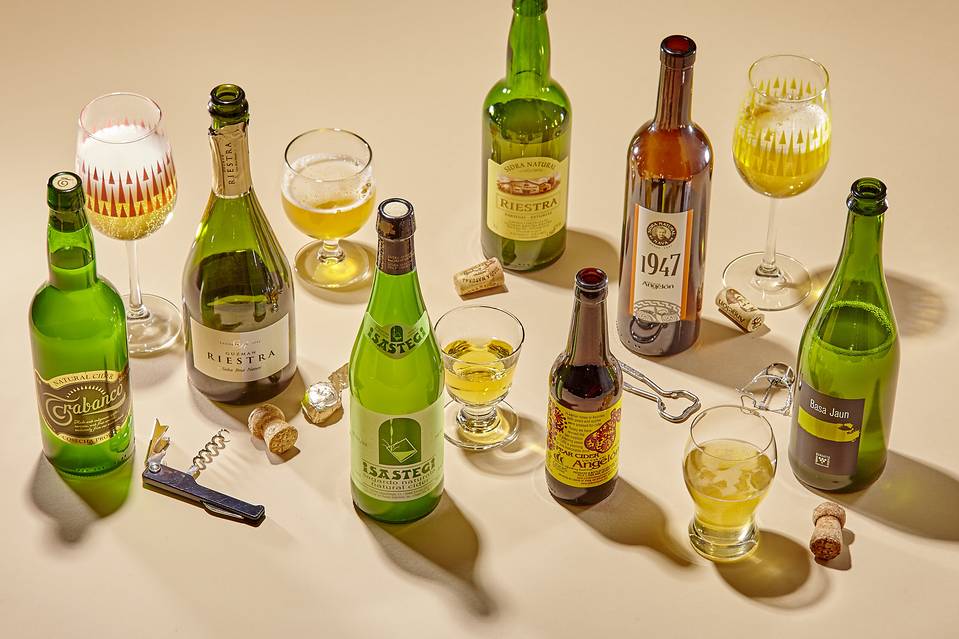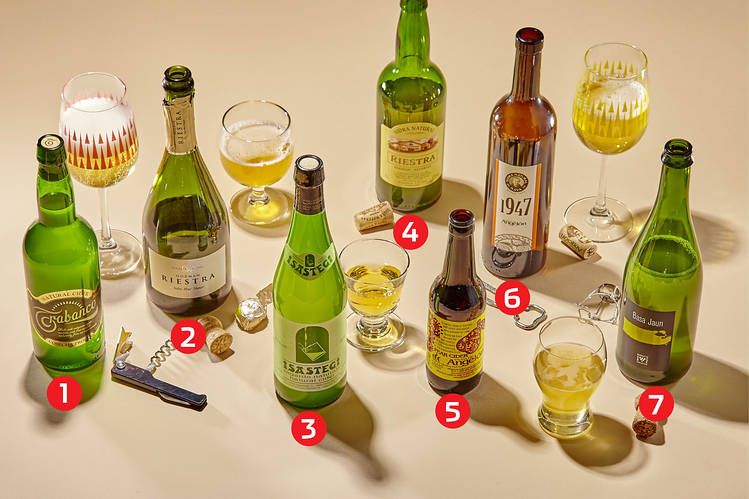
Insider Cider: Tips on Top Bottles From Spain
Invigorating, earthy, dry and highly drinkable, Spanish ciders express a wild side we forgot the apple had. Here are 7 bottles worth seeking out

Photo: F. Martin Ramin/The Wall Street Journal
By
William Bostwick
Sept. 21, 2017 12:20 p.m. ET
Apples abound at this time of year, as fall’s signature fruit spills from grocery bins around the country. But a crop so common still holds mysteries. Spanish cider, or sidra , reveals surprising facets of the apple (and occasionally the pear, too).
An ancient style that’s landed stateside relatively recently, sidra is even winning over drinkers who had all but given up on cider. Until recently, Max Toste, owner of Deep Ellum bar in Allston, Mass., found all the ciders he tasted too sweet, too one-note. “Just apple juice,” in his words. And for the most part, he was right: The majority of modern American cider is made not with old-fashioned cider apples—tannic, complex, powerfully sour fruit full of the acids that give good cider its sweet-sharp balance—but with the lunchbox-friendly sugar bombs most domestic orchard acreage is given over to these days.
Then, 10 years ago, Mr. Toste had a fateful sip. A friend had a find he wanted Mr. Toste—always a fan of odd, old beverages—to try. The corked, green-glass bottle with an indecipherable label held no clues. The liquid inside, poured into a delicate, thimble-size cup, was cloudy and nearly flat. And yet that cool dram gave off fireworks of flavor: tangy, earthy, spicy, bone-dry. “I couldn’t believe how complex it was,” Mr. Toste recalled.
He had found sidra, and he went on to make an enthusiastic study of this category. Spain grows hundreds of apple varieties—some 200 in Asturias, a region not quite the size of Connecticut on the Bay of Biscay from which most Spanish cider hails. These are “craggly apples you can’t eat raw,” Mr. Toste said. Varieties range from puckering Raxao to sharply bitter Regona, and frequently a single sidra will feature several.
And whereas American and British cider makers favor clean- and crisp-fermenting lab-grown yeasts, sidra ferments au natural, slowly and with relatively little resulting carbonation, thanks to wild yeasts and souring bacteria in the orchards where the apples grow. “It’s not about intervening or interfering, but curating what nature does,” said James Asbel, founder of U.S. importer Ciders of Spain.
Pick of the Bunch
Outstanding Spanish Ciders to Sip this Fall

Photo: F. Martin Ramin/The Wall Street Journal
- 1. Trabanco Cosecha Propia (6% ABV) A great entry-level cider, sour and simple like Granny Smiths and grapefruits. Soft enough to drink alone but with a cutting edge that complements mellow, lighter autumn fare like fabada , an Asturian bean stew.
- 2. Guzmán Riestra Sidra Brut Nature (8% ABV) Bottled using France’s traditional méthode Champenoise, this bright and bubbling geyser of sharp funk is a perfect pairing with oysters.
- 3. Isastegi Sagardo Naturala (6% ABV) Funky and fresh, a Basque Country splash of salty ocean spray, racing and prickly. The fruit comes through woody and musty—fallen apples in piles of autumn leaves.
- 4. Sidra Natural Riestra (6% ABV) Made from equal quantities tannic Normandy apples and sour Spanish ones, this cider is still, dry and cloudy with a smoothly lactic, buttermilk bite. Great with fried seafood.
- 5. Viuda de Angelón Sidra de Pera (5.2% ABV) A sparkling pear cider made from tannic cider-specific cultivars. Low in sugar but blossoming with fruity, floral notes—an orchard in late-season bloom. Delicious with cheese or fruit desserts.
- 6. Viuda de Angelón 1947 Sidra de Nueva Expresión (6% ABV) Slightly sparkling, spicy and warm as fresh-baked pie. Less sharp than most, this one's nice served at room temperature, to let its fuller-bodied sweetness shine.
- 7. Bordatto Basa Jaun (7% ABV) A variety show of 19 different apples, blended and bottle-aged. Slightly sweet with a rough, mineral finish: green apple rock candy, emphasis on the rock.
Though made simply, cider is served with flourish in Spain, poured from a wall-mounted barrel or bottle held high, sending a long arc of liquid into a small glass called a culín. The real point of this trick, called escanciar , or throwing, is aeration. The atmosphere at Spanish cider houses is raucous—sawdust-covered floors sodden with cast-off dregs, rafters echoing folk songs—and above the din, the ceremonial, thunderous txotx , or tapping of the cider barrels.
In autumn, cider is served with harvest feasts of hearty farm-country fare. “The north of Spain is similar to the northeast U.S. in its weather and its food,” said Jonah Miller, chef at Huertas, a restaurant in Manhattan heavily focused on the cooking (and accompanying drinks) of northern Spain. “In Asturias, rich stews and braises. In the Basque Country, big T-bone steaks.” For all of which cider makes an ideal match. “In winter you might want something heavier, like a red wine, but in fall cider is light and refreshing but tart enough to cut the fat,” Mr. Miller added.
Fitting, then, that the best places to find these ciders in America are a new generation of restaurants like Huertas that aim to reveal a more nuanced picture of Spanish food, beyond the tired tapas and paellas that have often stood in for Iberian cuisine in this country. A combination of new Spanish cooking and customers willing to explore the more adventurous flavors of funk and sour have set the stage for sidra to gain ground here.
‘In winter you might want something heavier, like a red wine, but in fall cider is light and refreshing.’
Still, sidra can, as yet, be hard to find outside of restaurants already hip to its charms. And when you do come upon a few sidras at your local bottle shop, how to choose the best? Mr. Toste has his own rule of thumb: The less English on the label, the better. “Look for all those crazy Basque words, lots of Ts and Xs.”
Forget helpful listings of apple varieties or stamps indicating protected designation of origin. But you can generalize: “Basque ciders have a reputation of being more vinegary, more acetic, more tannic,” said Mr. Toste. “They’re made in a coastal area with more salt in the air, and closer to France, so they use French apples, which are more tannic.” Asturian cider skews earthier and funkier.
But each cider producer is as unique as its trees and the microbes flourishing among them. Blame—or thank—that untamed fermentation. Nature commands the process of making sidra. They’re all exciting, but the only way to truly know what’s in each bottle is to taste for yourself.
Appeared in the September 22, 2017, print edition as 'The Insiders’ Cider.'
